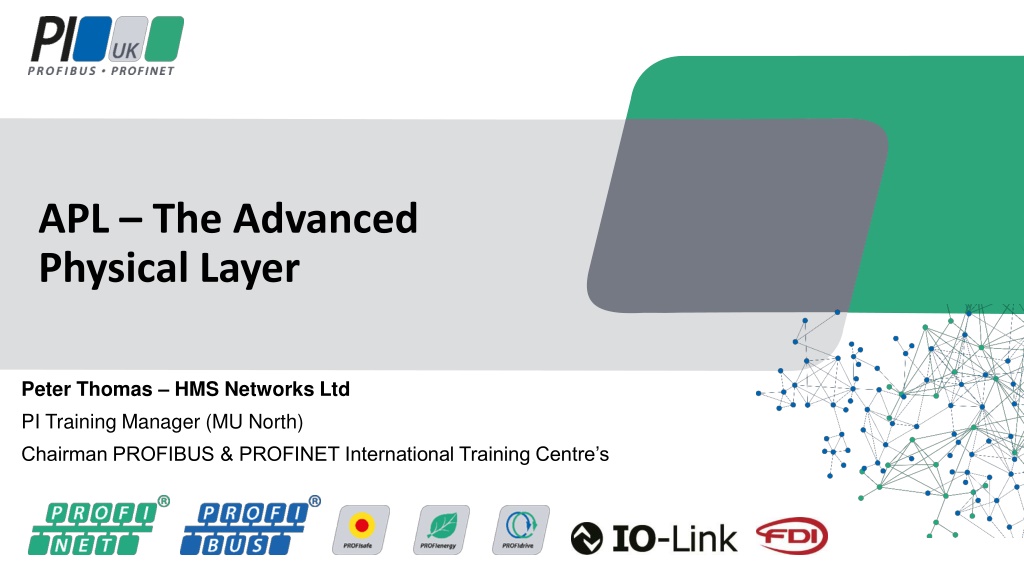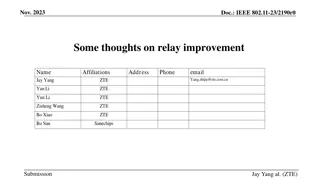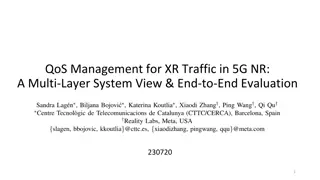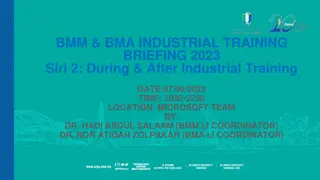APL - The Advanced Physical Layer in Industrial Networks
APL, the Advanced Physical Layer, is transforming the process industry by offering an Ethernet-based alternative to traditional fieldbus methods like PROFIBUS PA. Through APL, enhanced connectivity, efficiency, and flexibility are achieved. The technology involves topologies, cabling specifications, couplers, and considerations for hazardous areas, providing a comprehensive solution for modern industrial networks.
Download Presentation
Please find below an Image/Link to download the presentation.
The content on the website is provided AS IS for your information and personal use only. It may not be sold, licensed, or shared on other websites without obtaining consent from the author. Download presentation by click this link. If you encounter any issues during the download, it is possible that the publisher has removed the file from their server.
Presentation Transcript
APL The Advanced Physical Layer Peter Thomas HMS Networks Ltd PI Training Manager (MU North) Chairman PROFIBUS & PROFINET International Training Centre s
APL A game-changer for the Process Industry For over 30 years, PROFIBUS PA has facilitated a fieldbus-based alternative to the long- established 4-20mA method of connecting field-based instrumentation to a centralised control system. The Advanced Physical Layer, or APL, now provides a route of using Ethernet, instead of Profibus PA, to bring similar benefits to those achieved when migrating from PROFIBUS DP to PROFINET. 2 PI UK Glasgow 2023 APL The Advanced Physical Layer
PROFIBUS PA Topology PROFIBUS PA topologies generally follow a trunk line from which individual instruments are T off via using multi-port junction boxes or segment protectors PA slave PA slave PA slave PA slave DP PA slave junction boxes T T DP/PA coupler PA slave T PA slave Power supply PA slave PA slave PA slave Termination normally built in to coupler Other termination in last junction box (preferred position) 3 PI UK Glasgow 2023 APL The Advanced Physical Layer
PROFIBUS PA - Cabling Every segment of a safe-area PROFIBUS PA network uses two-core twisted pair / screened cable to carry both power and data to each device. The total length of cable in every safe-area segment must not exceed 1.9Km, including the lengths of the drops down to each instrument. You can have up to 32 devices in a safe-area segment, but length drops can reduce this to as low as 12. Construction Shielded twisted pair 0.8 mm2 Conductor area 100 20% at a frequency of 31.25kHz Impedance 44 / km Loop Resistance 4 PI UK Glasgow 2023 APL The Advanced Physical Layer
PROFIBUS DP/PA Couplers Because PROFIBUS DP and PROFIBUS PA use two different electrical transmission systems, DP/PA couplers are required to convert from RS485 (DP) to Manchester Bus Power (PA). DP/PA LINK SEGMENT PROTECTOR COUPLERS Diagnostic Module 5 PI UK Glasgow 2023 APL The Advanced Physical Layer
PROFIBUS PA & HAZARDOUS AREAS By default, PA devices and DP/PA couplers are for safe-area use only. However as long as suitably-rated devices and couplers are used and specific rules relating to cable length and device count are followed, PROFIBUS PA can be used in Hazardous areas using EX ib or Ex ia. The limitations are: Cable length limited to 1km Length of drops to instruments limited to 60m No of devices are typically limited to around 8 per segment (FISCO rules) 6 PI UK Glasgow 2023 APL The Advanced Physical Layer
APL is not just a PI project 7 PI UK Glasgow 2023 APL The Advanced Physical Layer
APL and Ethernet APL is completely standard Ethernet and differs only in its physical aspects. i.e. Layer 1 in the 7-layer OSI model. Unlike PROFIBUS PA, which used the PROFIBUS DP protocol, APL is an open communications standard that supports standard TCP as well as several industrial ethernet protocols 8 PI UK Glasgow 2023 APL The Advanced Physical Layer
Conventional Ethernet v APL Images Endress+Hauser 9 PI UK Glasgow 2023 APL The Advanced Physical Layer
Comparisons with other Ethernet types Industrial Ethernet Ethernet APL Single Pair Ethernet Specifications IEEE 802.3u / 100BASE-TX IEEE 802.3cg-2019 - 10BASE-T1L Hazardous Areas ? NO Explosion hazardous areas including intrinsic safety (via 2-WISE in IEC 60079-47) NO Power Concept Separately Powered APL Port Profiles (loop-powered or separately powered) up to 15 VDC and 0.5W Power over Data Line (PoDL) acc. IEEE 802.3bu -up to 30 VDC and 8W Connectors RJ45 or M12 D-coded Terminals or M12 A-coded SPE connectors or M12 A-coded Switches Standard Switches APL Field Switches SPE Switches Protocols Industrial Ethernet real-time protocols, e.g. PROFINET, EtherNet/IP, Modbus TCP Standard Ethernet applications, e.g. http 10 PI UK Glasgow 2023 APL The Advanced Physical Layer
APL 2-Wire / Full Duplex Images Endress+Hauser 11 PI UK Glasgow 2023 APL The Advanced Physical Layer
APL Support APL devices are starting to appear from several global organisations. A new PROFINET PA module has been added to the existing Certified PROFINET Engineer course 12 PI UK Glasgow 2023 APL The Advanced Physical Layer
APL Proven Technology The first test was set up with nearly 240 Endress+Hauser measuring devices, including flow, pressure, temperature and level sensors. They were integrated into a system with Pepperl+Fuchs field switches and a Honeywell control system, all using Ethernet- APL and PROFINET. For the second test ABB provided the control system and was tested along with the previous field switches and measuring devices. Images Endress+Hauser 13 PI UK Glasgow 2023 APL The Advanced Physical Layer
APL Proven Technology The test results were conclusive: Ethernet-APL can be used under realistic circumstances. The test cases were carried out with maximum network layout, and the scalability and fault tolerance were successfully verified. All relevant requirements like total netload or redundancy switch-over times were met or exceeded. 14 PI UK Glasgow 2023 APL The Advanced Physical Layer
Case Study - BASF The chemical company BASF have recently completed a proof on concept project using APL. The results of this are published on the Automation World web site: https://www.automationworld.com/ They set three clear objectives:- 1. To obtain additional data from the devices to allow a digital twin to be created. 2. To collect similar data from across its sites to provide a better insight into their operations and promote standardization in maintenance and remote overseeing of operations. 3. To aggregate the data overtime to allow correlations to be identified and optimisation to be improved. 15 PI UK Glasgow 2023 APL The Advanced Physical Layer
APL Switches (EX ic) Powered spur ports intrinsically safe Ex ic according to 2-WISE and FISCO (11.6v, 95mA and 1.11W) PROFINET MRP, S2 redundancy and dynamic reconfiguration 2 ports each for 1000BASE-T and SFP transceivers Redundant power input 20 VDC ... 60 VDC Installation in Zone 2 Physical layer diagnostics at the spur Configuration and diagnosis with FDI, web interface, PROFINET device functions and SNMP Support of network security Support of Ethernet-APL and PROFIBUS PA instruments 16 PI UK Glasgow 2023 APL The Advanced Physical Layer
APL Switches (EX ia) Powered spur ports intrinsically safe Ex ia according to 2-WISE and FISCO (9.6V, 55.56mA and 640mW) PROFINET MRP, S2 redundancy and dynamic reconfiguration 2 ports each for 1000BASE-T and SFP transceivers Redundant power input 20 VDC ... 60 VDC Installation in Zone 2 Physical layer diagnostics at the spur Configuration and diagnosis with FDI, web interface, PROFINET device functions and SNMP Support of network security Support of Ethernet-APL and PROFIBUS PA instruments 17 PI UK Glasgow 2023 APL The Advanced Physical Layer
PROFINET S2 Redundancy 18 PI UK Glasgow 2023 APL The Advanced Physical Layer
Typical Topologies (Symbols) Engineering Guideline Ethernet-APL 19 PI UK Glasgow 2023 APL The Advanced Physical Layer
Typical Topologies (Ethernet Trunk) Engineering Guideline Ethernet-APL 20 PI UK Glasgow 2023 APL The Advanced Physical Layer
Typical Topologies (Unpowered Trunk) Engineering Guideline Ethernet-APL 21 PI UK Glasgow 2023 APL The Advanced Physical Layer
Typical Topologies (Powered Trunk) Engineering Guideline Ethernet-APL 22 PI UK Glasgow 2023 APL The Advanced Physical Layer
APL and Hazardous Areas APL uses a concept called 2-WISE (2-Wire Intrinsically Safe Ethernet). All used equipment must be certified according to 2-WISE. The cable used to connect switch, field device and auxiliary device to a spur may be up to 200 m and must follow the following specification: 23 PI UK Glasgow 2023 APL The Advanced Physical Layer
Spur topology with field switches installed in Zone 2 Engineering Guideline Ethernet-APL 24 PI UK Glasgow 2023 APL The Advanced Physical Layer
Spur topology with field switches installed in Zone 1 Engineering Guideline Ethernet-APL 25 PI UK Glasgow 2023 APL The Advanced Physical Layer
APL Cyclic and Acyclic Data The main function of an APL device is to accurately measure and relay its process value, e.g. temperature, pressure, flow etc. These will used by the control system to control the various process using PID controllers. PID control is a time-critical functionality and it is vital that the process variables are read on a regular / cyclic basis for the individual P, I and D terms to work correctly The actual cycle period is a function of the natural speed of the process. The main benefit of APL is the facilitation of access to large amounts of data that do not need to be read as often, this is called acyclic data. 26 PI UK Glasgow 2023 APL The Advanced Physical Layer
FDI and Access to Acyclic Data FDI or Field Device Integration facilitates acyclic access to data in each process device. It effectively combines the benefits of its predecessors Device Type Manager/Field Device Technology (DTM/FDT) and Electronic Device Description Language (EDDL) FDI was jointly developed by leading process industry foundations including FieldComm Group, FDT Group, PROFIBUS & PROFINET International, and the OPC Foundation. Major supplier companies including ABB, Emerson Process Management, Endress+Hauser, Honeywell, Schneider, Siemens, and Yokogawa supported the project with significant resources. 27 PI UK Glasgow 2023 APL The Advanced Physical Layer
FDI Data Flow 28 PI UK Glasgow 2023 APL The Advanced Physical Layer
Questions Peter Thomas HMS Industrial Networks Ltd PI Training Manager (MU North) peth@hms-networks.com 29 PI UK Glasgow 2023 APL The Advanced Physical Layer

















































